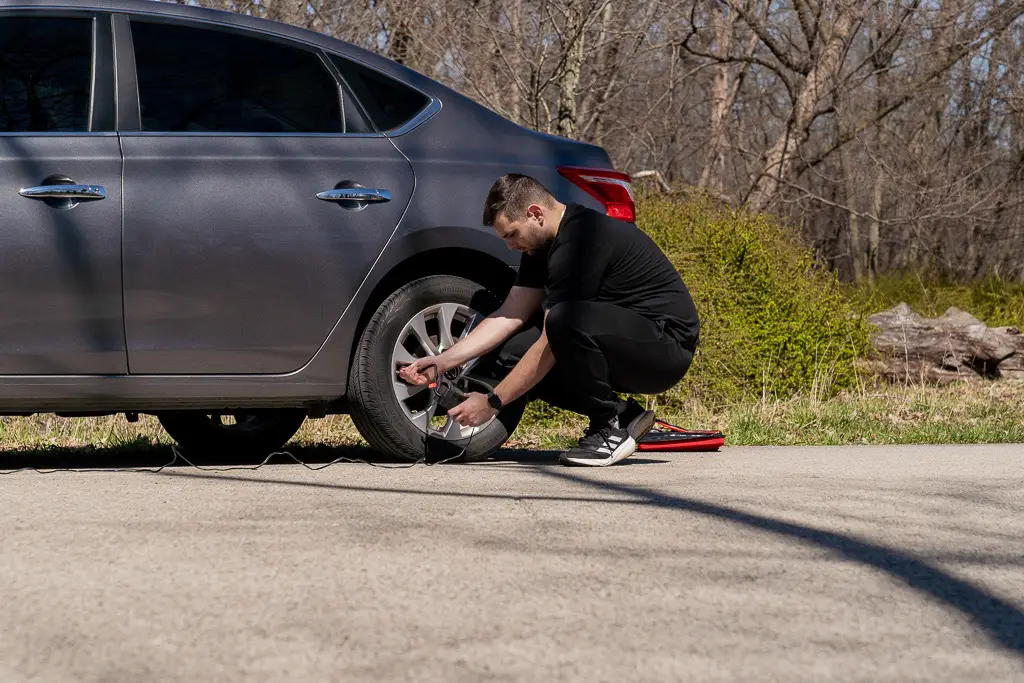
Have you noticed that your low tire pressure light has been coming on more frequently, and does it seem like your tires lose air all the time? Having to constantly check your tire pressure and top up the air in your tires is annoying and a waste of your precious time. Plus, driving on tires with low tire pressure can cause problems with handling, damage your tires, and even be dangerous.
So if you want to fix this, read on to learn the answer to the question ‘Why do my tires keep losing air’, plus discover the all-important solutions!
What causes a slow leak in a tire?
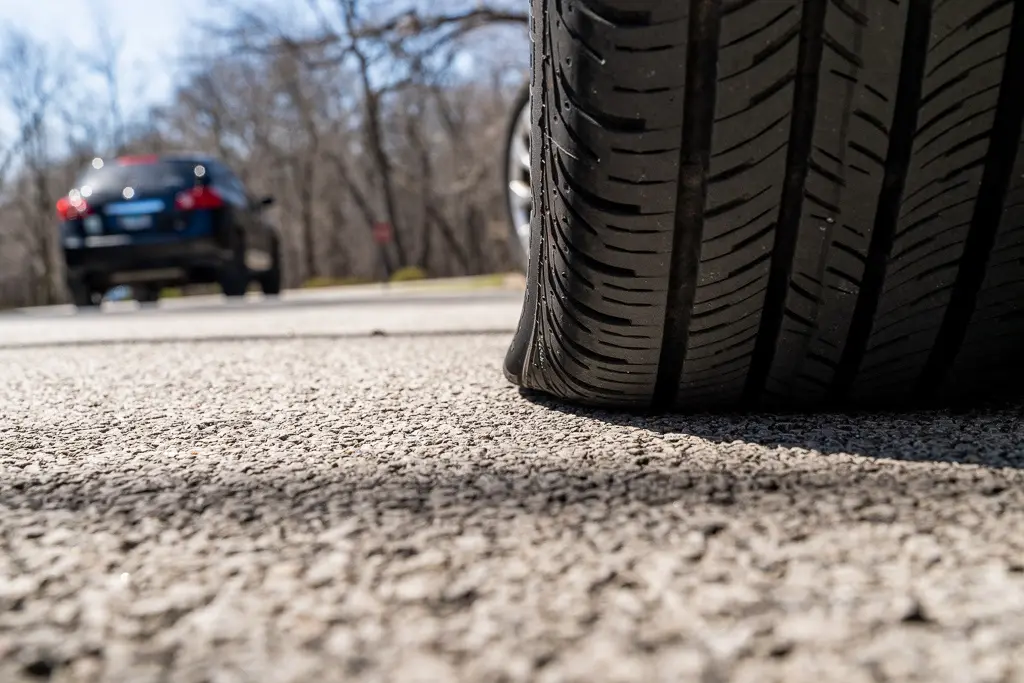
Before you start panicking that your tires are going flat or you’ve got a faulty tire pressure sensor, you should be aware that there are some perfectly normal reasons why tire pressures change.
Normal air loss
Tires always lose a little air pressure, generally at about 5-10% a month (10–20kPa). This is why having a tire pressure gauge at home is important and checking your pressure regularly.
Weather changes
A tire losing air and cold weather are also closely related, as temperature fluctuation affects the air pressure. You may notice this during the change of seasons, particularly in winter. If temperatures drop by 18°F, you’ll see a 3-4% drop in tire pressure. Equally, when the weather gets much hotter, you’ll find a 3-4% increase in pressure for every 18°F increase in temperatures.
This is only a real issue when temperatures drop for long periods, as quite often, the difference between day and night temperatures is enough to cause a small fluctuation overnight. So, if your vehicle spent a night outside in the cold and you find the tires are underinflated in the morning, don’t rush to add pressure. As the day warms up, the pressure will return to normal by the afternoon.
This is because pressure air expands when heated and shrinks when cooled. The amount of air should remain the same, so if there is no other damage to your tire and temperatures are likely to revert to normal, you can keep the pressure as it is.
However, if your tire has deflated more than 25% from the recommended pressure, it can be dangerous, and your chance of getting into tire-related crash triples. This is generally the point when your tire pressure monitoring system will alert you to a problem.
Therefore, it’s crucial to carry out a regular tire pressure inspection and repair the issue. These issues are either down to the car’s wheel, tire valve, or the tire itself.
Let’s look at these issues in more detail.
Wheel or tire valve problems
Wheel damage or corrosion
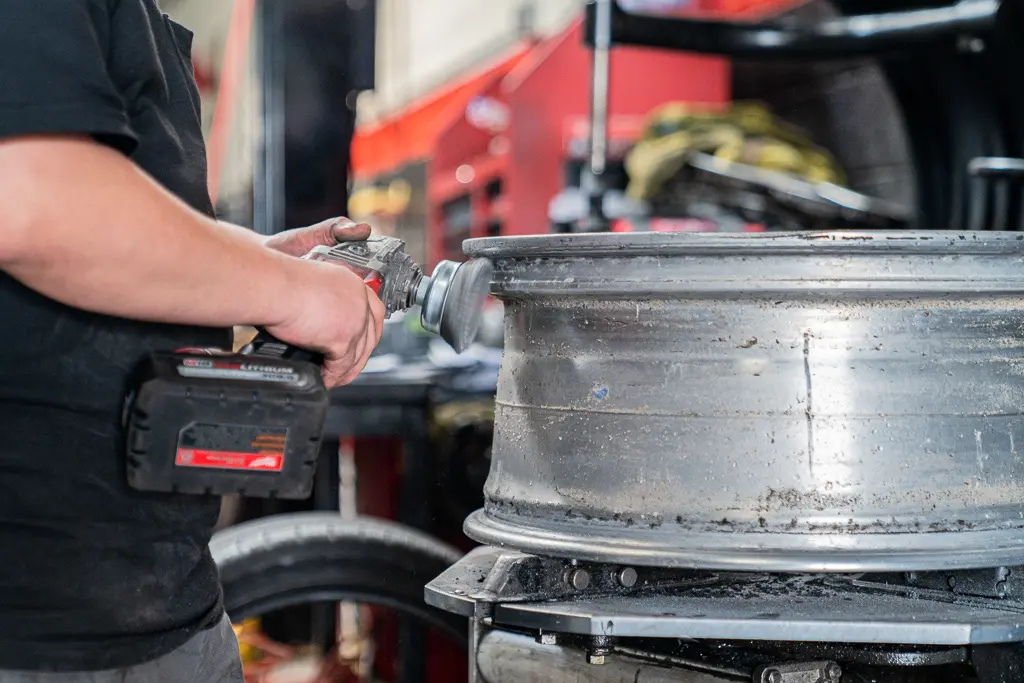
Wheels, especially made of aluminum, can corrode over time, particularly if exposed to salt (hello, winter roads) or moisture. This corrosion can eat away at the wheel’s surface, leading to a poor seal with the tire bead and, you guessed it, air loss.
If you hit a pothole or other road hazard, your wheel can also lose its perfectly round shape. This can mean the tire doesn’t fit as well, and once again, you’ve got air leaking out!
Tire valve leak
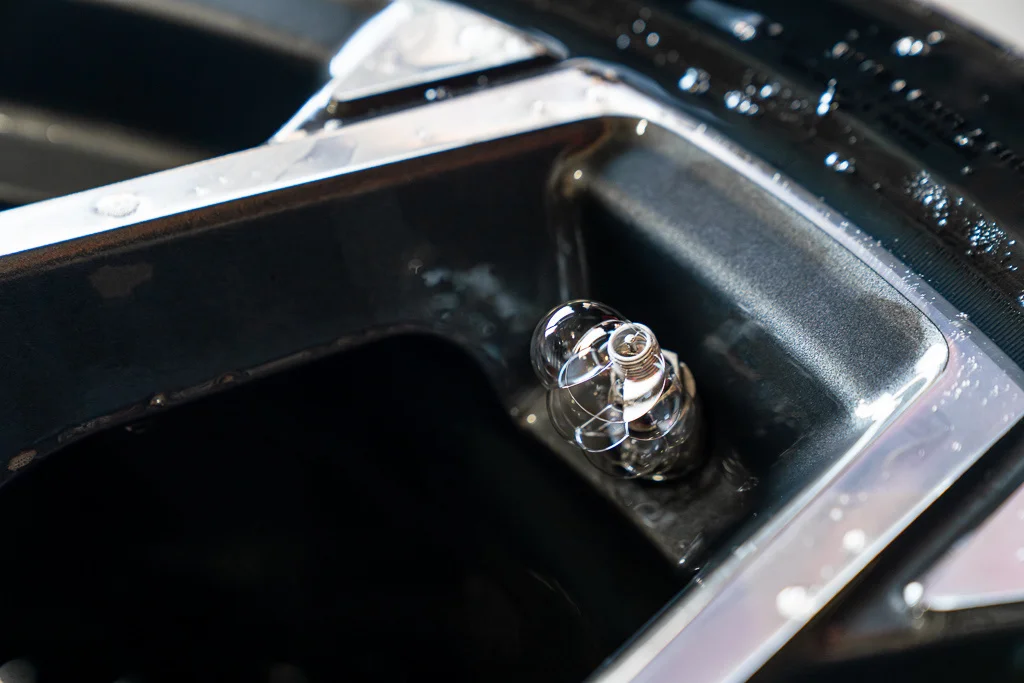
The valve stem is your tire’s airlock, where the air enters and leaves. But it can grow weak, especially if damaged or worn out. A compromised valve stem can leak air out of your tire, leading to gradual pressure loss. Regular checks can help catch these leaks early, preventing bigger problems.
Valve stems can be damaged by chemical exposure, either in the garage or on the road. They also wear out over time. Usually, they should last as long as your tires, but if you notice air loss of over 1-3 psi a month, they may need replacement earlier.
Another potential cause of damage to valve stems is over-tightening them. So be careful not to force them too tightly closed.
Missing tire valve cap
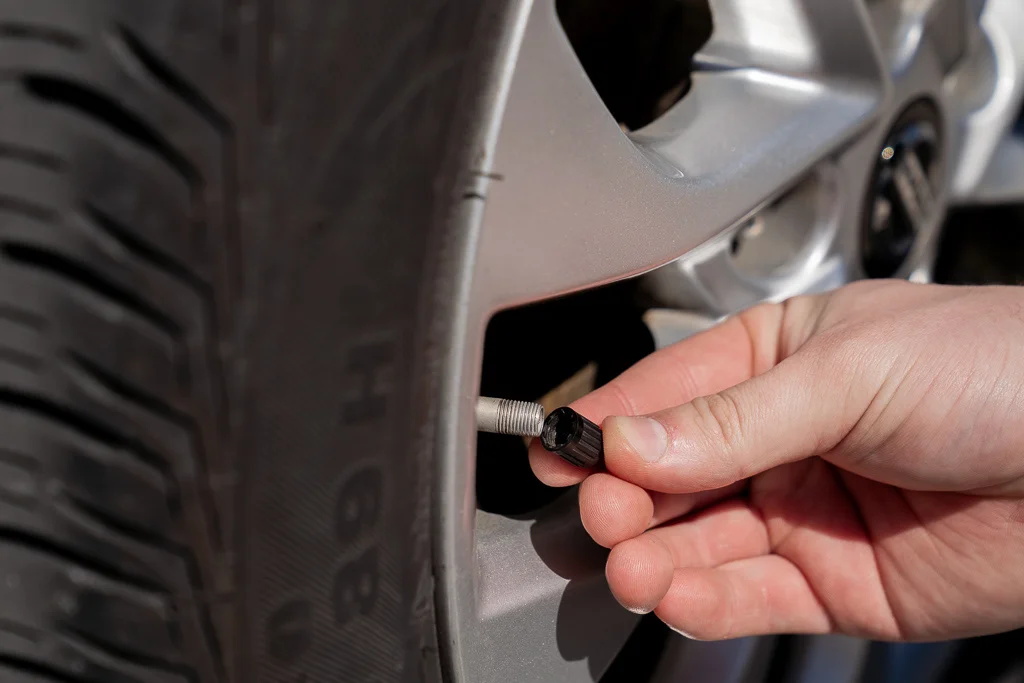
This is the easiest fix of all, and if this is your problem, it can be quickly remedied by buying a new valve cap. However, don’t leave it too long to replace the cap, as it plays a crucial role in protecting the valve from dirt, moisture, and direct damage. A missing cap might seem inconsequential, but it can lead to leaks and contamination of the valve core.
Tire problems
Along with problems with the wheel and tire valve, your tire itself can be the reason you’re losing air. So what causes slow leak in tires?
Tire damage
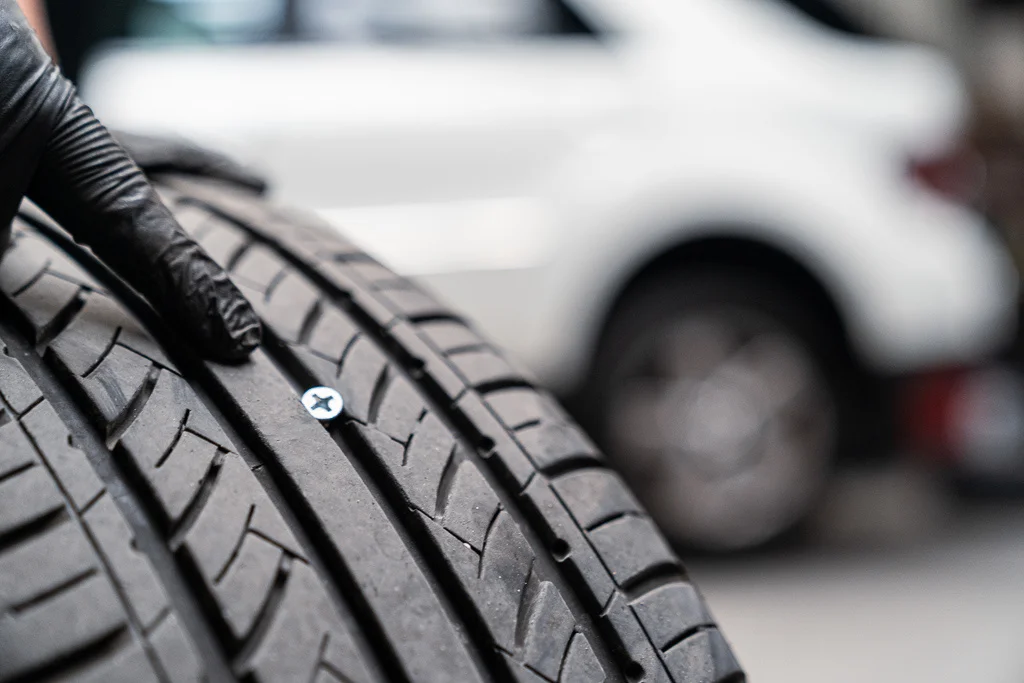
Your tires are your car’s only contact with the road, and the road isn’t always kind. Hitting a pothole, driving over sharp objects, or simply the wear and tear of daily use can cause damage leading to air loss. Regular inspections can help spot these problems early, preventing minor issues from becoming major leaks.
The classic cause of a flat or leaking tire is a tire puncture. Whether it’s a nail, shard of glass, or any sharp object on the road, punctures are a direct hit to your tire’s air retention capabilities.
Nails can puncture the tire and cause air to leak at the rate of 2-3 psi a day. A nail may remain in the tire and cause seemingly insignificant air loss. But it still needs to be extracted. If it isn’t, the leak could get worse, and your tire may need an urgent repair to make sure you don’t get a completely flat tire.
Driving over a large pothole or a curb may flex the tire sidewalls and make the tire lose air. If there is no damage to the tire-wheel unit, you may just need to re-inflate the tire. However, check for any sidewall bulges, cuts, and punctures. These may indicate internal or external damage that could contribute to the leak.
Tire bead leak
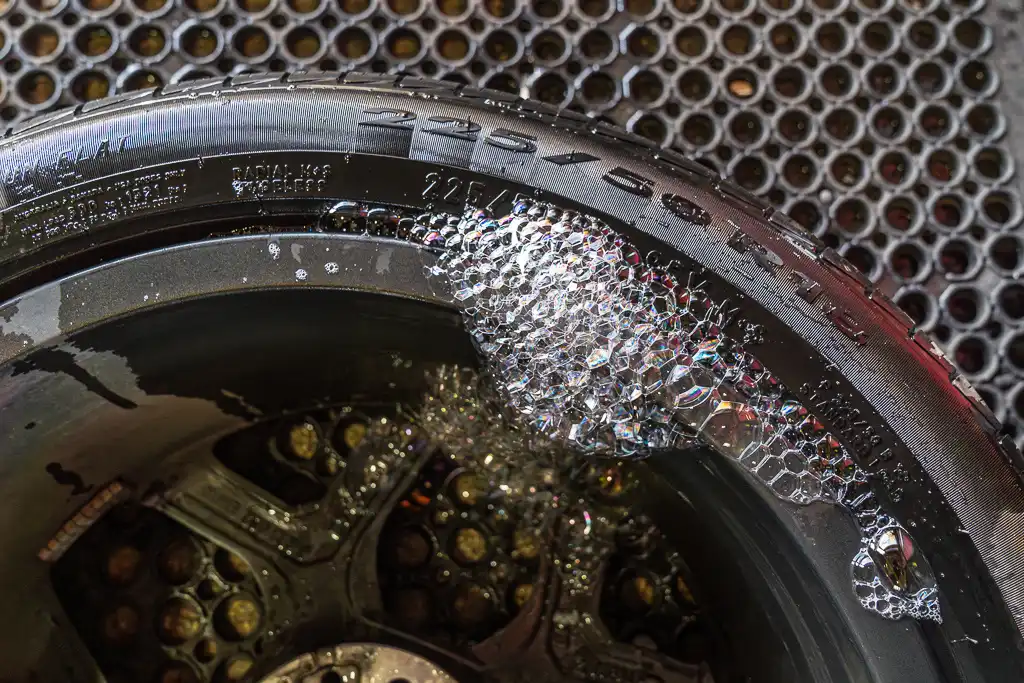
You can also get slow leaks from issues with your tire bead. The tire bead is where your tire hugs the rim, creating an airtight seal. However, if this seal is broken or compromised, air can escape, leading to slow leaks. Corrosion on the rim, debris getting stuck between the bead and the rim, or damage to the bead itself can be the culprits behind this type of leak.
Dry rot
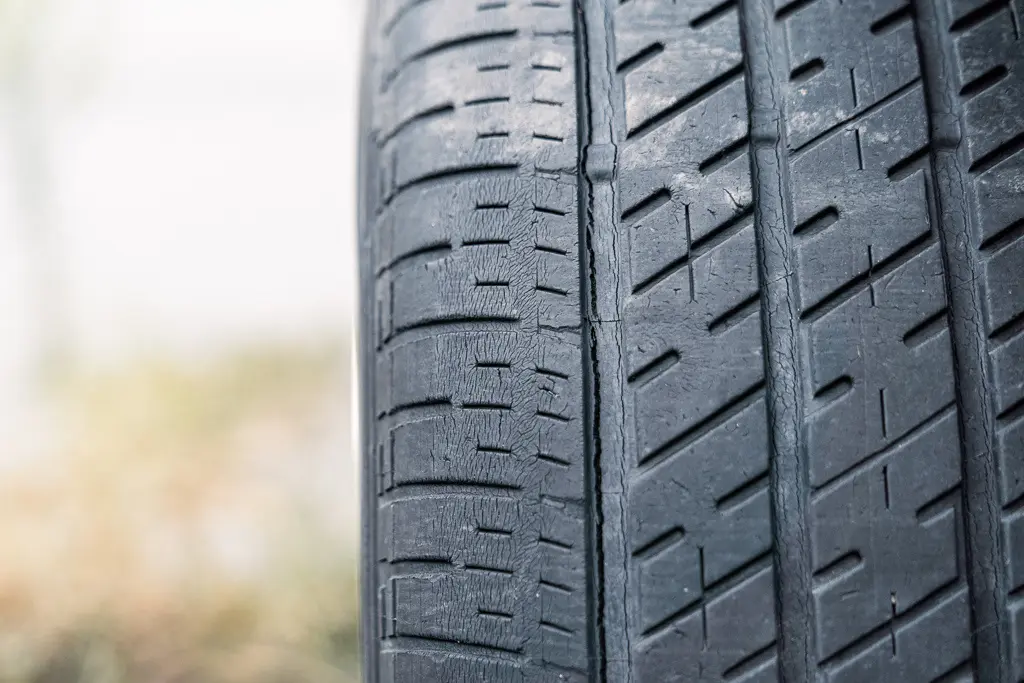
Tires, unfortunately, don’t get better with age. Exposure to the elements, especially the sun’s UV rays, can cause the rubber to break down and crack, a condition known as dry rot. This deterioration can lead to a slow leak, air loss, and, ultimately, tire failure. That’s why it’s so important to know the age of the tire before you buy it.
What to do when my tires lose air?
Locating the air leak
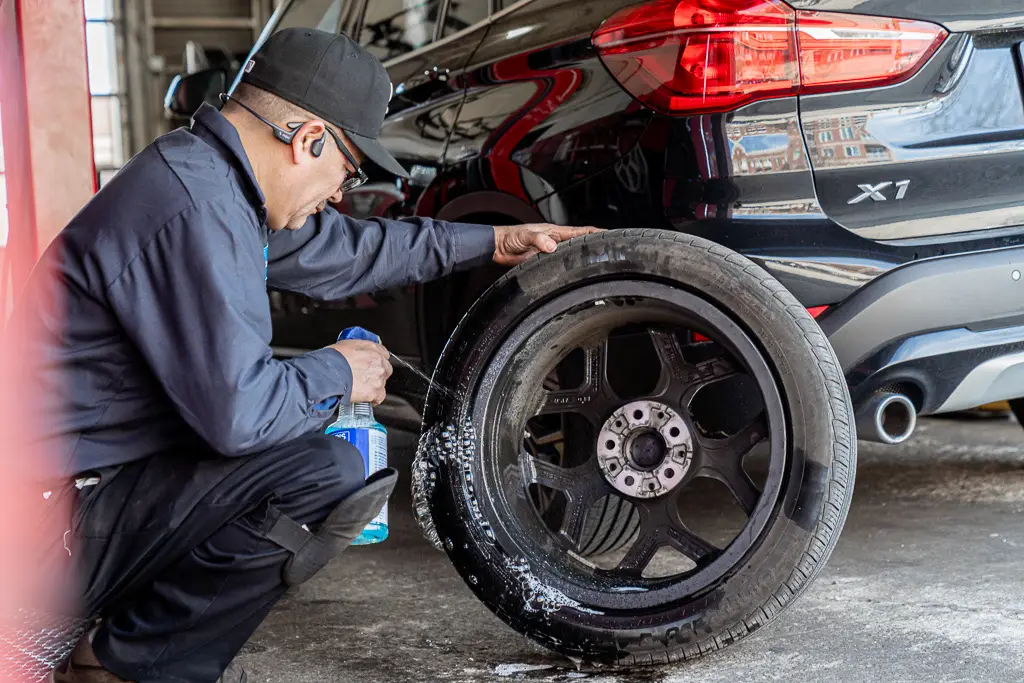
If your tire loses air slowly, there are several ways to find the leak:
- By using soapy water.
Add any soap or 20% detergent into a spray bottle with water and spray the tire and rim edge. Cover the valve stem with the mixture first, then the inside and outside edges of the rim. You can also pour some on the tire sidewalls and tread to see if there’s any damage you might have missed. Bubbles will appear where the leak is present. However, remember that you may need to wait for about 5 minutes before you notice the place where your tire loses air slowly. - By putting the wheel into water.
Remove the wheel from the vehicle and put it into water. The leaky part will start to release small bubbles and show itself. The puncture or other damage may be on the other side, so if you don’t see any bubbles after 5 minutes, turn the tire over.
Usually, the soapy water method works perfectly, even for small punctures. It’s also the easiest and least time-consuming, as you don’t have to remove the tire.
Fixing tire leaks
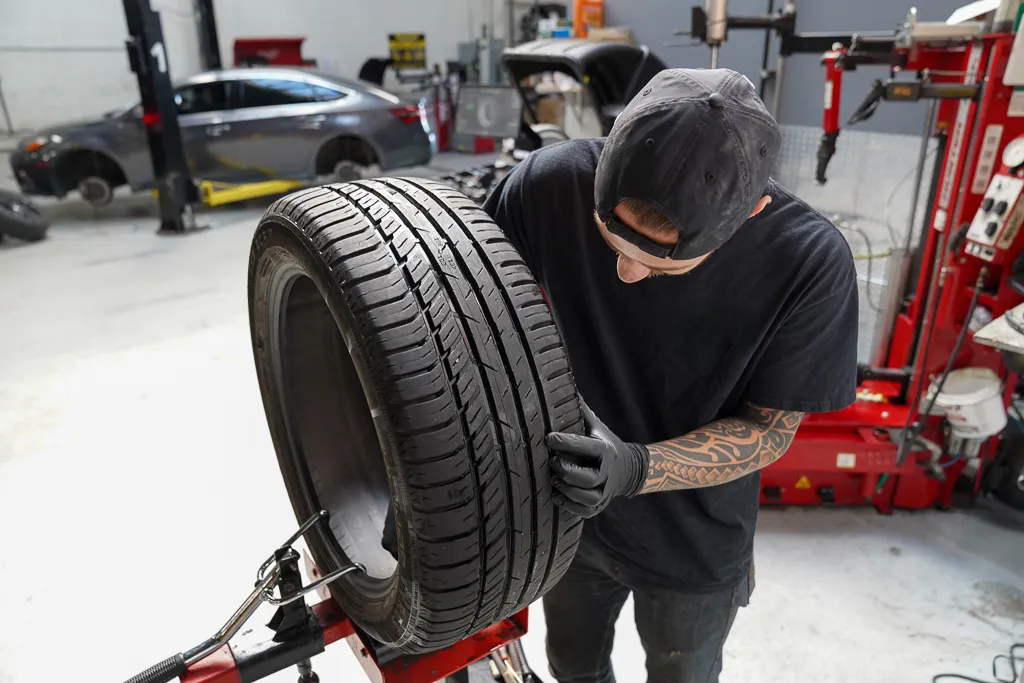
If your tire loses air slowly, there are several things you can do:
- Repair the tire
- Repair the valve stem
- Repair and/or restore the rim
NOTE: Not all damage to the wheel and tire are reparable. Some repairs are temporary, giving you time to get to the nearest tire shop. But you should never drive with temporary or poor-quality repairs daily.
Repairing a tire
You can get your puncture fixed by a technician at a tire workshop, or you can try to fix it at home. If you want to do it yourself, use a special plug kit. This method is only suitable for punctures in the tire tread, not the sidewall. Also, it’s only a temporary fix!
Using a plug kit
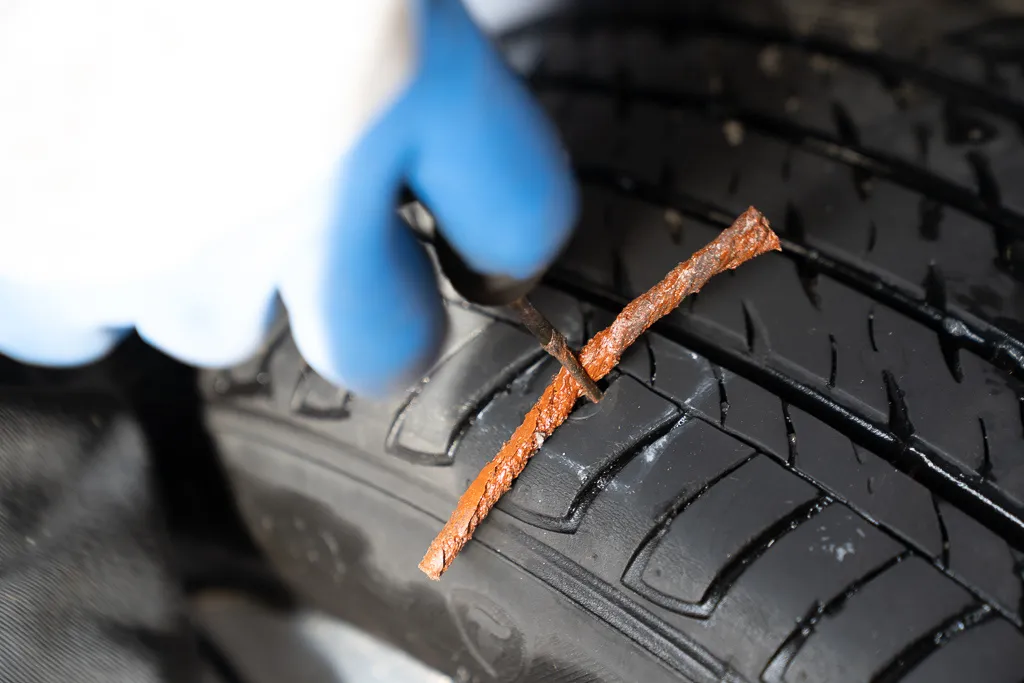
A plug kit contains:
- a set of plugs
- rubber cement
- a reaming tool
- a plug tool
Before starting work on your tire, make sure you have pliers or a tool that can remove a nail or other sharp object from the tire. You may also need a car jack and a lug wrench if it’s more comfortable to repair the tire after removing the wheel. However, you can repair this while the wheel is still on your car.
To repair your punctured tire:
- First, remove the nail or other foreign objects puncturing the tire.
- Then use the reaming tool to clean the hole and make it fit the plug. Be careful not to make the hole too large, or you won’t be able to repair the puncture.
- Next, insert the plug into the plug tool and cover the tip of the tool with a bit of rubber cement.
- After that, insert the plug into the hole in the tire and pull the tool out.
- Then cut off any of the plug that sticks out above the surface. Make sure to cut it as close to the tread as possible.
- Finally, after the repair has dried, you can pump the tire up and drive away.
NOTE: Remember that this type of repair is a temporary fix and is suitable for tread damage only. If you try to fix the sidewall with a plug kit, the tire may blow out at any moment.
If you still decide to install a plug, we recommend driving to the tire shop ASAP after. A mechanic will inspect your tire and let you know his verdict. He’ll install a mushroom plug—a more permanent solution if possible. If not, you might need to buy a new tire.
Suppose you keep driving with a “self-installed” plug. In that case, it can result in slow tire pressure drop, insufficient pressure for tire rolling, excessive heat generation, and, as a result, sidewall destruction.
Repair tire valve stem
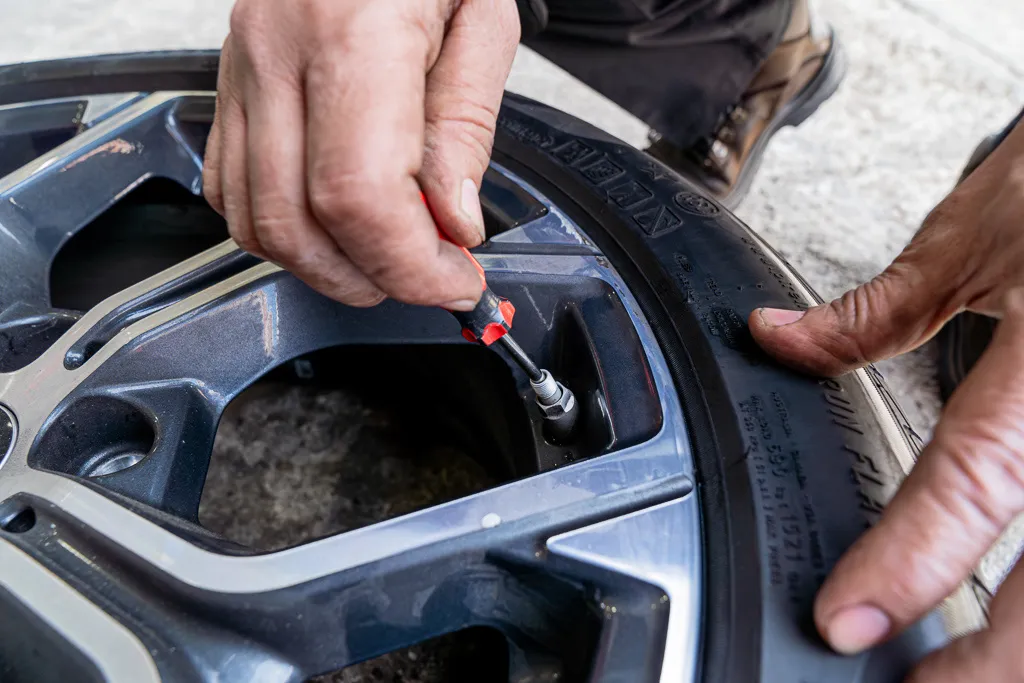
If your valve stem is damaged but your tire is still good, you can replace it. You’ll need a valve removal tool and a new valve core to do this. You may also need a car jack and a lug wrench to remove the wheel if you find it easier.
How to change a valve stem:
- Remove the valve core from the wheel by inserting the removal tool tip into the stem and rotating it counterclockwise.
- Clean the stem before installing a new core if you see signs of corrosion.
- Screw a new core in place.
- Reinflate your tire.
NOTE: Wear protective glasses, as the old core or debris from the stem may fly out and hit you.
Repairing and/or restoring the rim
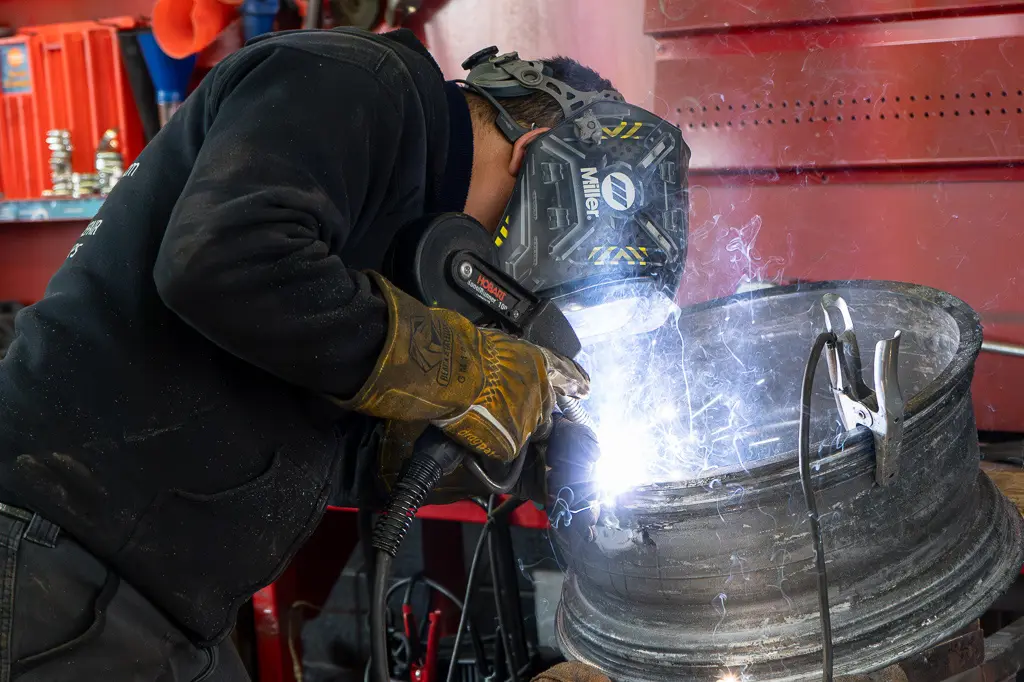
If you have a bent or corroded rim, you have a couple of options. If the wheel rim is bent, it’s best to go to a mechanic, as they can offer hydraulic assistance. This is one of the newest and most efficient ways to straighten a wheel and will give you the best long-term results.
NOTE: Never hammer your aluminum alloy wheels, as this can damage them beyond repair. Aluminum is quite brittle, so more gentle methods should be used to fix aluminum alloy rims.
Rim maintenance
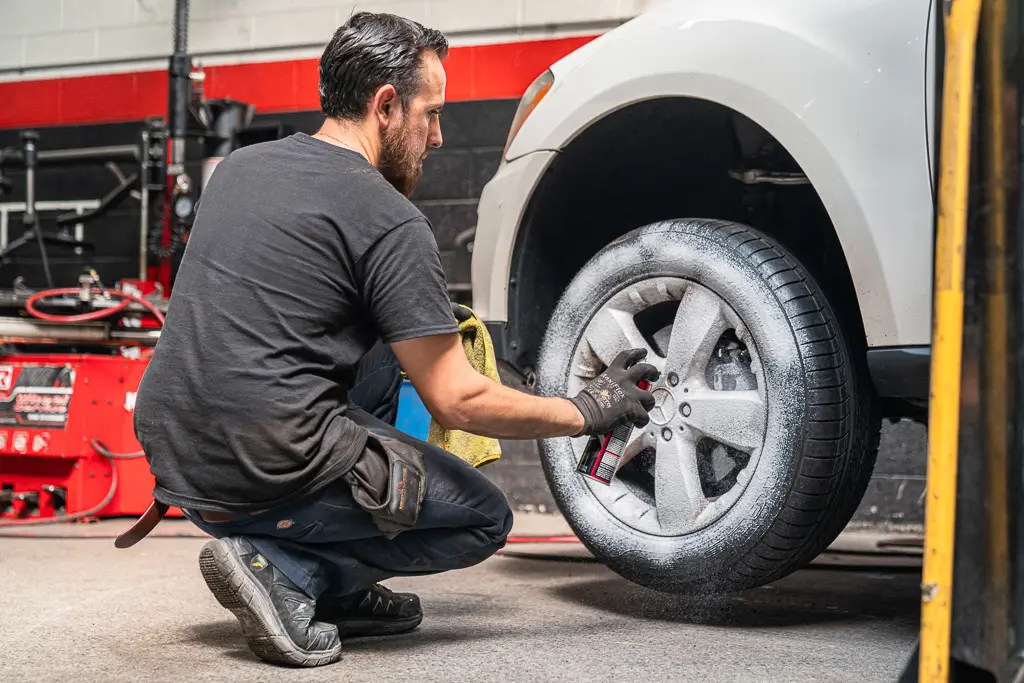
While you shouldn’t try and repair a damaged rim yourself, you can clean and maintain them. Removing wheel corrosion is a good idea, as this is one of the reasons why a tire loses air slowly. You’ll need sanding tools, metallic aluminum polish, and wax (optional) to do this.
To clean your rims:
- First, remove the wheel from your car and remove the tire.
- Clean the wheel and degrease it.
- Then remove all the paint and previous finishes.
- Sand all its parts thoroughly, including the space between the spokes and inside the lug-nut holes.
- Use a low-speed sander to clean the rim’s center, and polish it all until it looks new.
- Finally, let it dry and apply wax if you want a waxed finish.
NOTE: This is only one of the methods for cleaning corrosion from your wheel. The method you use may vary depending on your wheel type and manufacturer’s specifications. You should also wear protective glasses and gloves while cleaning your rims.
Maintaining your vehicle’s air pressure
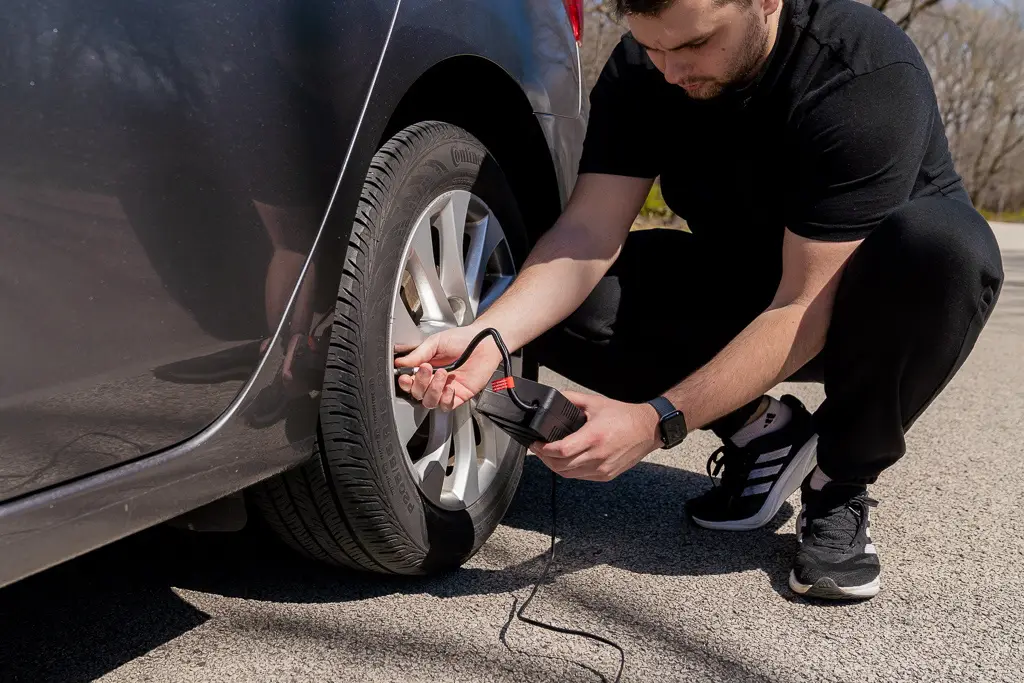
It’s essential to keep an eye on your tire’s air system and to carry out a tire pressure check regularly.
- Check regularly
Check your car’s tire pressure once a week to make sure you’re quickly aware if any of your tires are losing more air than the others. - Check when cold
Make sure you check your tires while they are cold. You don’t need to wait too long for them to cool down – 2 hours should be fine. Also, ensure the car has been in the shade before checking the pressure. If you’ve been driving for over 15 minutes or the car has been in the sun, remove 2 psi to see the real inflation rate. - Use a calibrated pressure gauge.
Not all tire pressure gauges are as accurate. Check your local gas station to see if they regularly calibrate their pressure gauges. You need an accurate gauge because every psi lost makes a difference when a tire loses air slowly. Even a new gauge may show about +/- 3 psi, which can make a difference for light passenger cars. Also, choose the most appropriate tire gauge type for you: stick, digital, or dial. You can see their benefits and drawbacks by reading a buying guide.
Finding your recommended air pressure information
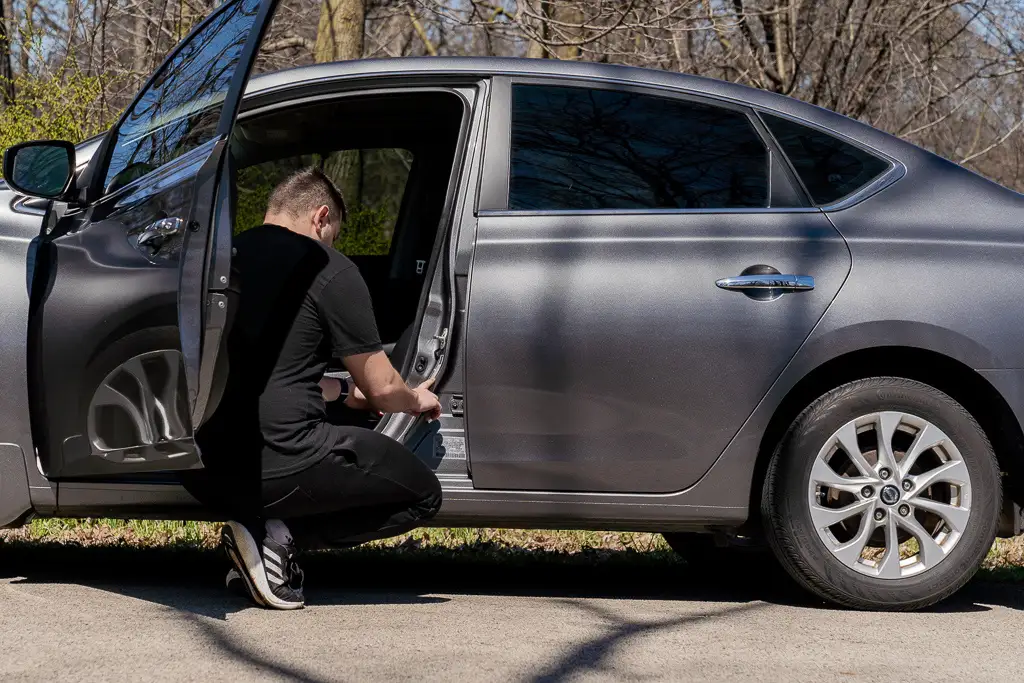
To find the recommended tire pressure for your car, check your vehicle owner’s manual or look for the information sign on the door frame. This will give you figures for maximum load/inflation and the recommended amounts.
It’s important that your tire load index is the same or more than the index you see on the sign. The information on the load index can be found on the tire’s sidewall as part of its code.
Tire rotation and balance
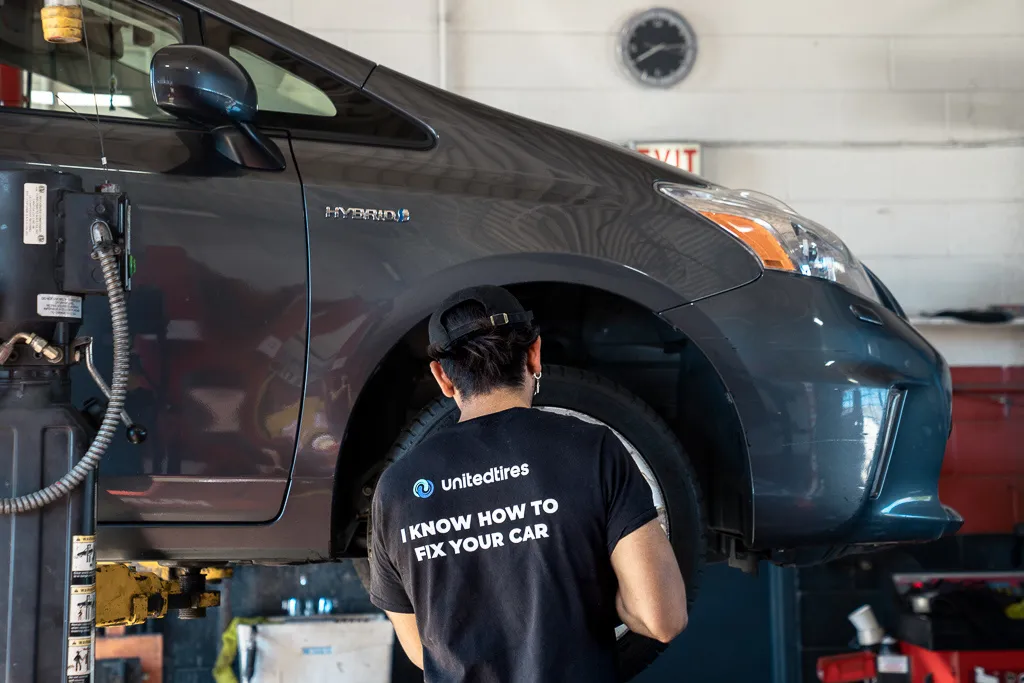
Another important factor in keeping your tire’s air pressure healthy is tire rotation and balancing. If you carry out regular tire rotation and balancing, this will ensure your tires wear evenly, which can prevent leaks caused by uneven stress and wear on the tires.
Rotate your tires according to your vehicle manufacturer’s recommendations, typically every 5,000 to 7,500 miles. Balancing should be done simultaneously to ensure even weight distribution across all tires.
Inspecting tires for damage and wear
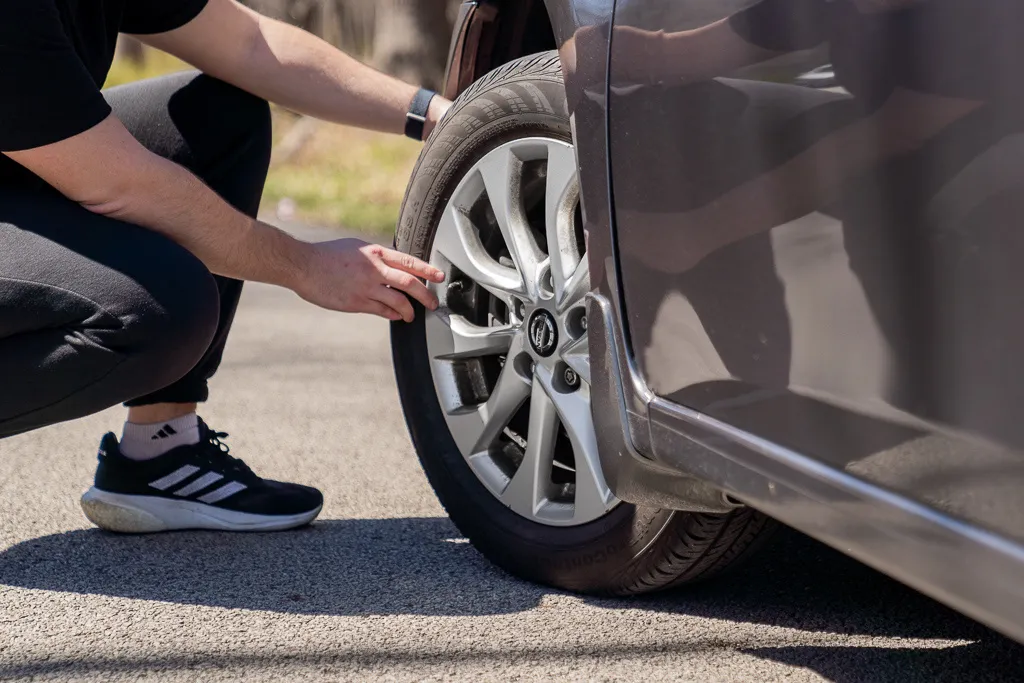
The final step in ensuring you have healthy tires is regular visual inspections. They can catch issues before they lead to air loss. Look for signs of wear, damage, or foreign objects lodged in the tread. Check for cracks, cuts, bulges, or other signs of distress on the tire sidewalls. Addressing these issues early can prevent leaks and other tire-related problems.
Why tire pressure is important
It’s important to keep your tires at the correct pressure for several reasons.
- Safety: Unfortunately, a lot of people don’t regularly check their tires. This can lead to accidents as your car will be less stable and handling will be affected. Additionally, about 75% of roadside flat tires could be prevented by checking the pressure and repairing problems when a tire loses air slowly.
- Load-carrying capacity: Did you know that you need a different tire pressure if you have a full car? Your car can only carry the specified maximum loads if the tires have enough air in them.
- Tire lifespan: Tires are expensive, and maintaining the correct tire pressure ensures you get a long life out of your tires. When they are over- or under-inflated, your tires start to wear irregularly, so they need to be replaced sooner.
- Fuel consumption: Gas is expensive, and having the wrong tire pressure can cost you. Did you know that your fuel consumption will go up by 2-5% when your tire pressure drops by 50kPa (0.5kgf/cm2) below the appropriate level (figures from The Energy Conservation Center, Japan)? So checking your tire pressures once a month can save you money.
So, having the wrong pressure can cause many problems, increasing your risk of flats and blowouts and costing you more money for tires and gas. The average psi standard for a light passenger car is 35, and tires with this pressure become dangerous at 28 psi. So, you can see that even 5-7 psi makes a difference. So keep an eye on your tire pressures regularly!
Frequently asked questions
Why does my tire keep losing air but no hole?
It’s frustrating when your tire keeps losing air, but there’s no visible puncture. One common reason could be a leaking valve stem or a damaged valve core. Over time, these components can deteriorate or become worn out, causing slow air leaks. Another possibility is a bead leak, where the tire doesn’t properly seal against the rim. This can happen due to corrosion, debris, or improper installation. Another possibility is that temperature changes can affect tire pressure, leading to seemingly mysterious air loss.
To pinpoint the issue, have a professional inspect your tire and valve components thoroughly. Regular maintenance checks and keeping an eye on your tire pressure can help catch and address these problems early, ensuring a safer and smoother ride.
How do you fix a tire that keeps losing air?
If your tire keeps losing air, the first step is to identify the source of the problem. Start by visually inspecting the tire for any obvious punctures or damage, which can hopefully be repaired. If none are found, check for faulty valve stems, missing valve caps, and the bead seal against the rim, and ensure it’s mounted properly. Sometimes a simple tightening of the valve stem or cleaning the bead area can solve the issue.
If the problem persists, visiting a trusted mechanic or tire professional who can thoroughly inspect your tire and recommend the appropriate repair is best. Remember, staying on top of tire maintenance and regularly checking tire pressure can help prevent issues before they become a bigger problem down the road.
Why do my tires lose air so quickly?
Tires losing air too quickly can be a headache, but there are several common reasons behind it. One possibility is simply wear and tear over time. As tires age, they become more susceptible to leaks and air loss. Another common reason is punctures from things like nails or broken glass, which can create slow leaks. Sometimes, an old or faulty valve stem can lead to air loss.
A less dramatic reason might be a missing valve cap or even changes in temperature. Rapidly dropping or rising temperatures can cause changes in tire pressure, which makes it seem like your tires are losing air rapidly. Whatever the cause, it’s a good idea to get your tires checked by a professional to keep driving safely.
